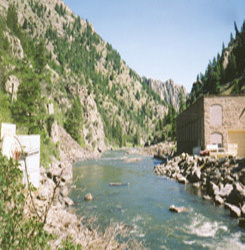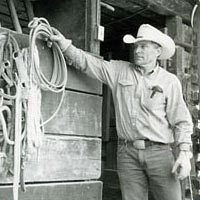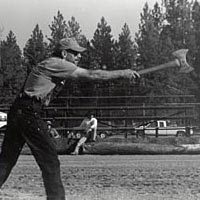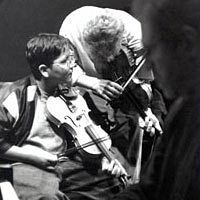
- Capital City:
- Helena
- Nickname:
- Treasure State
- Motto:
- Oro y Plata (Gold and Silver)
- Statehood:
- November 8,1889 (41st)
- Origin of State's Name:
- Based on Latin or Spanish word for "mountainous"
- Largest Cities:
- Billings, Great Falls, Butte, Missoula, Helena
- Border States:
- Idaho, North Dakota, South Dakota, Wyoming
- Land Area:
- 145,556 sq. mi., 4th largest
- State Bird:
- Western Meadowlark
- State Flower:
- Bitterroot (lewisia rediviva)
- State Tree:
- Ponderosa pine (pinus ponderosa)
- State Song:
- Montana
Montana is known as "Big Sky Country". The members of the Lewis and Clark expedition were the first white explorers known to have set foot in Montana. It joined the United States in 1889 as the 41st state. The name Montana comes from the Spanish word Montana, meaning "mountainous," although the eastern part of the state consists of gently rolling pastureland. The Anaconda Company had a stranglehold on the state's copper industry for about 100 years, but today Montana is known as a tourist destination for those drawn to its many trout streams and wide open spaces. Its capital is Helena and the state flower is the bitterroot.
History of Farming and Ranching

Five St. Ignatius High School students present and preserve their area's native traditions using text of interviews with farmers and ranchers of the Mission Valley of Montana and with 26 8 x 10 photographs. The text of a report summarizing their findings was written by their teacher Marta Brooks. Students in Brooks' English and history classes used the "heritage education" approach to the study of local culture. They collected stories, oral histories, historical documents, art and geological information that reflect the merging of landscape and culture. Project materials include interview transcripts with local residents involved in dairy farming, potato and grain farming, cattle ranching, horse ranching and hog raising. Included also is an agriculture report on Lake County by Jack Stivers, County Extension Agent.
Montana's agricultural communities rely mainly on cattle and grain production, yet, on the local level, Montana's traditional farmers and ranchers are becoming a dying breed. Although new technologies, improved marketing strategies, and government involvement may have improved life for some farmers and ranchers, life has become more complicated for the rural farmer, who has been beset by successive financial crises and changing global weather patterns. At the 1999 World Trade Organization meeting in Seattle, 40 Montana farmers and ranchers gathered to voice their discontent with agricultural trade barriers that are pinching them more than other farm communities because of a lack of diversity. Moreover, the 1990s saw a decrease in Mission Valley in the numbers of farms and ranches of 100 to 1,000 acres. They were being replaced by 10 to 40 acre "ranchettes," and with them an influx of new urban born-and-bred emigres from California or other states, who had come to escape city ills but who had no roots in the local traditions and heritage. The change in the local landscape with the inevitable change in the local culture that followed have raised the concern of the long-time local farmers and ranchers and prompted this project to document and preserve the area's native culture and traditions before they are obliterated.
Libby High School: Documenting Local History

During the summer of 1999, a group of teenagers -- some Libby High School students, some recent graduates -- formed a team led by local history teacher Jeff Gruber to tell the world why Libby is unique and explain their pride in their community. Some of the students had been involved in Libby's Montana Heritage Project, some were interested in photography and some in history, but each called on his/her unique talents and interests to document their view of what it was like to live in Libby. Logging and mining industries dominate Libby's economic life, while civic activities such as Logger Days and Nordicfest, and the weekly summer car wash to raise money for local clubs and organizations, define the small Montana community.
Nordicfest is an annual celebration of the town's Swedish heritage, recalling the days in the early 1900s when a lumber mill was established in Libby and recruited Scandinavian loggers from Minnesota. Started in 1985, the three-day event features craft and quilt shows, a parade and Fjord horse show, and culinary treats like Swedish meatballs and "Vikings on a stick." As the men play accordions, women dance in their festive bunad costumes.
Logger days, a four-day festival held in early July, celebrates Libby's historic timber industry with food, parades, and crafts. But the highlights of the celebration are logging competitions such as "Bull and Bullette of the Woods," the "Ma and Pa Relay," "Donut Stacker," "Jack and Jill Race," "Log Loading," "Truck Wrapping," the "Lumberjack Relay Crew," and sawing and ax throw events. Festivities are kicked off with a traditional water fight staged by the Libby Volunteer Fire Department, and a Logger Day Queen is crowned who presides over the festivities.
As well as Libby's celebrations, the team documented the local timber industry, the mainstay of Libby's economy, by taking a field trip into the lush Kootenai National Forest. There they learned about logging practices and forest management, and observed timbermen and their machines at work. The students also studied the area's mining industry, which began in 1866 when down-on-their-luck miners struck gold on a creek nestled in the Cabinet Mountains. The Libby Legacy team panned for gold on Libby Creek, learned the basic geology of the area, investigated old mining cabins, and explored modern mining techniques.
Montana Is...

A book of poetry illustrated with original photographs by cowboy poet Mike Logan. The book came to be as an afterthought: Logan wanted to share some of the beauty he had been privileged to see and photograph in his 21 years living in Montana. In his introduction to the book, Logan asserts: "I love everything about Montana....I still feel like I'm spending every day in heaven." Montana Is... was also issued as a video, a roundup of Logan's visual impressions of Big Sky Country, its ranch life, scenic beauty and spectacular wildlife.
Logan first moved to Montana in the 1968, and in the ensuing years, he has spent many days in its wilds, hunting and photographing this "marvelous big-skied state." Logan's keen insight and expansive western spirit have won him national acclaim, and he has been the featured poet at cowboy poetry gatherings throughout the U.S. and Canada. In 1991, he was a guest on John Denver's television special "Montana Christmas Skies." His words and photography have appeared in numerous books, magazines and calendars. Often inspired by the paintings of the great cowboy artist Charles Russell, Logan's poems reflect his deepest vision of what "Montana is...."
The Metis Project: When They Awake

Helena Presents, a production, presentation and film center based in Helena, Montana, created and produced When They Awake, a celebration of the extraordinary legacy of fiddle music of the Metis people. The project explores the musical and social legacy of a tribe without boundaries, whose heritage results from marriage between Indians and Europeans throughout the Northern Plains from Sault St. Marie, Michigan, to Choteau, Montana, across both sides of the 49th parallel. Central to the project is the creation of a new musical work that references the indigenous American rhythms and diverse European fiddle heritage that is present in Metis music. The name of the presentation is based on a prediction of Louis Riel, a teacher, writer, and hero to the Metis people:
My people will sleep for one hundred years, but when they awake, it will be the artists who give them their spirit back.
This new musical work was created and adapted in collaboration between a master Metis fiddler, a folklorist/scholar, and two composer/musicians. Composer/performers Philip Aaberg and Darol Anger collaborated with master Metis fiddler, Jimmie LaRocque.
 Print
Print Email
Email







